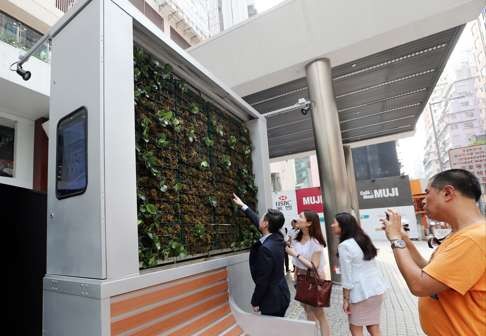
With pollution levels at maximum, can CityTree help clear Hong Kong's air?
Observatory says temperatures in the New Territories reached a new high for the year of 37.1 degrees in Ta Kwu Ling and Sheung Shui

Pollution levels across Hong Kong hit the government’s highest rating on one of the hottest days of the year on Friday thanks to severe typhoon Nepartak.
Murk and haze obscured the view across Victoria Harbour as air quality indicators at pollution monitoring stations clocked the highest “serious” category at all sites except the remote island of Tap Mun off Sai Kung, which registered a “very high” reading.
“The intense sunshine enhances photochemical smog activities and the formation of ozone, resulting in high pollution in the region,” the Environmental Protection Department said.
Children, old people and those with heart or respiratory illnesses were advised to avoid or minimise exercise and outdoor activity.
The Hong Kong Observatory said temperatures in the New Territories reached a new high for the year of 37.1 degrees in Ta Kwu Ling and Sheung Shui.
“Over the New Territories, in general, it’s very hot and in some areas it’s the highest this year,” senior scientific officer Wong Wing-tak said. He added the hottest day of the year was last month when the mercury topped 35.5 degrees, It reached 34.2 degrees on Friday in Tsim Sha Tsui.
In a bid to tackle serious roadside pollution, a new installation called CityTree was placed outside Hopewell Centre last month to absorb and measure air pollutants such as fine dust particles and nitrogen oxides emitted from car exhaust.

The first of its kind in Asia, CityTree is made up of over 1,700 specially engineered moss cultures developed by the German startup Green City Solutions. The tree also includes a real time display of the levels of particle pollution detected by the tree’s sensors, which throughout Friday were lower than levels measured by the government’s nearby Causeway Bay monitoring station.
“Each CityTree can reduce air pollution within a radius of 50 metres by 30 per cent,” claims Denes Honus, CEO and co-founder of Green City Solutions.
Eric Or, managing director at JOS, a technology consultancy which managed the tree’s construction, believed its filtering effect was the equivalent of 275 oak trees, based on studies conducted by the German government.
However, tree specialist Jim Chi-yung from the University of Hong Kong had reservations about the tree’s effectiveness on streets shaded by skyscrapers. “Unlike in European cities, Hong Kong’s heavily shaded streets mean the moss’ photosynthetic rate, which its air cleansing rate depends on, will be much lower” Jim said.
There are 25 CityTrees across Europe in locations such as Oslo and Dresden. JOS is currently in talks to install more CityTrees around Hong Kong. “We wish to supply this service in other places in Asia too,” Honus said.